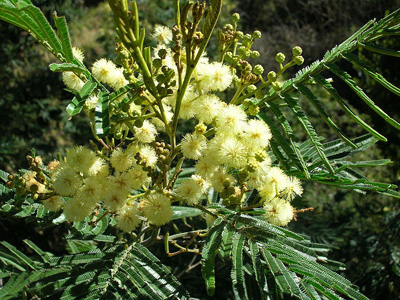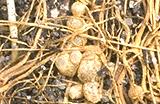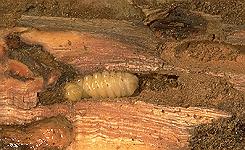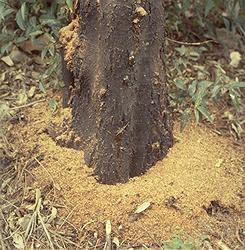|
[Front Page] [Features] [Departments] [Society Home] [Subscribe]

In Appreciation of the Common Black Wattle
Phil Watson
 |
 |
Wildflower walks and talks in woodland communities generally focus on all those pretty herbaceous understorey favourites. They display their delicate bright coloured blooms amongst the less spectacular framework of native grass, shrubs and trees.
One of the most common framework species often overlooked during Wildflower Wanders in November is Acacia mearnsii (black wattle). Although seasonally variable it is generally covered in full blooms of sweetly scented flowers by mid to late November.
So why talk about these boring, soft, green, fern leaf wattles? Let's pull them apart starting from the roots up and see what's interesting about them.
|
Acacia mearnsii - Photo: Forest & Kim Starr
Licenced under the Creative Commons Attribution 2.5 Generic license |
Roots
As a pioneer or scab plant their roots are first to rapidly bind the erosion prone soil following wild fires and like peas fix the atmospheric nitrogen in the soil. Woodland species can rapidly utilise these increased nitrogen levels provided by the nodules of rhizobia bacteria present in their expansive root systems.
 |
Legumes, such as wattles and pea-flowered plants, have root nodules which allow the plants to take up nitrogen directly from the atmosphere.
Select the thumbnail image or highlighted name for a higher resolution image (58k).
|
Mycorrhizal (meaning "fungus roots") fungi attach to their roots produce "yummy" truffles for bettongs, bandicoots, potoroos etc. The digging or "bio turbations" produced in search of these fungi create micro sites on the soil surface for difficult-to-germinate species.
A good feed of truffles will mean mycorrhizal spores are spread far and wide in the marsupials' droppings. This dispersal process perpetuates the symbiotic relationship between wattle's roots and the mycorrhizal fungi.
Bark
The cracks and crevices in the wattle's bark are home for many insects and invertebrates. The rare Tasmanian Hair Streak Butterfly lays her eggs in these cracks, which hatch to produce caterpillar larva attended by ants (Indomyrmex sp.) that feed off the sweet exudates from the larva.
When ready to pupate these "diary farmer"-like ants herd the larva down the wattle and across the grassy understorey to Eucalyptus viminalis where they pupate in protective bark crevices.
The tannin industry early this century thrived on tannic acid extracted from the bark (up to 45 per cent). The logging of the wattle caused rapid deforestations of our woodlands in the early 1900s. The highly valued tannins were used for tanning, plywood and particleboard adhesives and antiseptics. South Africa now has massive plantations of black wattle for this industry from where Australia imports its tannin products.
Aborigines used to soak the bark in a wooden waddie next to an open fire to extract their own antiseptics. Cuts and aching joints were treated with this decoction. They also used to split the bark into lengths of coarse string to produce baskets and bind the flint heads onto their spear shafts.
Wood
Black cockatoos love the grubs (wood moths etc.) in the black wattle wood and voraciously strip the bark for access to these borers.
 
Bark gleaner birds such as hornbills thrive on insects present under the bark.
"Wattle and daub" huts were constructed using the flexible limbs to structure a framework for supporting mud walls. This cottage style structure was common in early colonial history. Also, aborigines constructed their ‘lean to's' or ‘half dome' huts from these flexible limbs, covering them with bark sheaths or coarse foliage.
Black wattle provides comparable qualities to black wood (Acacia melanoxylon) as a craft wood for fine furniture manufacturing.
 
With no "whiteners" for sheets the colonists often relied on the burnt black wattle white ashes to help rid their soiled linens of dark stains.
These ashes also provided the basis for soap making producing a "lye" (or alkali) when mixed with water. This "lye" and fat (game meat) formed a chemical reactive mix ending in soap to be perfumed by herbal extracts or lavender oil.
Wattle grub frass (shown at the base of the tree - left) was a valuable fuel for fire lighting, and ensured the ease of rekindling glowing embers often carried by the aborigines.
Sap
The sap was prized as a food or drink dissolved in water with a dash of sweet wattle flower nectar and a few formic ants for a lemony flavour and quenching drink, a treat during their long journeys across the woodland landscape.
Mixed with ash when melted, it plugged holes in their water carrying vessels and watercraft.
The sap was so important that they melted and mixed it with burnt mussel shells or ashes and carried it about in balls when on walkabout.
When the black wattle was in full flower, the men of the aboriginal bands sharpened their flint headed spears. They understood that the flowering provided nature's indication that the roots were in the best condition for eating following a lush grazing period on the succulent, springtime grasslands and grassy woodlands.
During winter insects, birds and marsupials are hosted by the black wattle with the aid of their supplies of nectar in their leaf axials. These creatures provide an important predatory role to deal with tree die back caused by scarab beetles and pasture pests.
Black wattles, along with gums, native box, native hop form the framework vegetation on so-called "Hill-topping" sites. They are often isolated remnant pockets of native vegetation amongst a lower sea of exotic pasture. These "Hill topping" sites are critical habitat for male butterflies to attract females for mating, which then lay their eggs under the wattle's bark elsewhere but still within close proximity. It's the only acceptable mating site in the area for these butterflies.
Black wattle flowers provide very nitrogen rich pollen with no nectar. They attract pollen-feeding birds such as our Wattle Birds, Yellow Throated Honey Eaters and New Holland Honey Eaters. The protein rich nectar in the leaf axials is very sustaining for nurturing the growth of juvenile nestlings and young invertebrates, e.g. ants.
Seeds
Ants harvest the seed, attracted by the fleshy, oil rich elaisome (or seed stalk), which they bury and store in widely dispersed locations. These seeds are buried ready for germinating with the next soaking rains. However a "wattle seed-eating insect' which enjoys liquid meals using its proboscis-like injector to pierce the testa and suck out the embryo often reduces the seeds viability.
The seeds are highly prized by both the wandering aboriginals and jet setting modem day traveler alike. Think of those "wattle seed" biscuits passed out by the National Airlines — part of the bush tucker revolution.
Aborigines would grind the seeds into nutritious flour rich in polysaccharides and very high in protein content. Flat bread, baked in the ashes, was the delicious, wattle seed flower treat for the hours of grinding and winnowing.
Conclusion
So next time you are wandering the grassy woodlands at least give the black wattle a thought and cursory glance. This common tree deserves some of the respect so deeply engendered in the traditions of the local aboriginal tribes and early colonists.
From "Eucryphia", the newsletter of the Australian Plants Society (Tasmania), June 2000.

[Front Page] [Features] [Departments] [Society Home] [Subscribe]
Australian Plants online - September 2000
Association of Societies for Growing Australian Plants
|